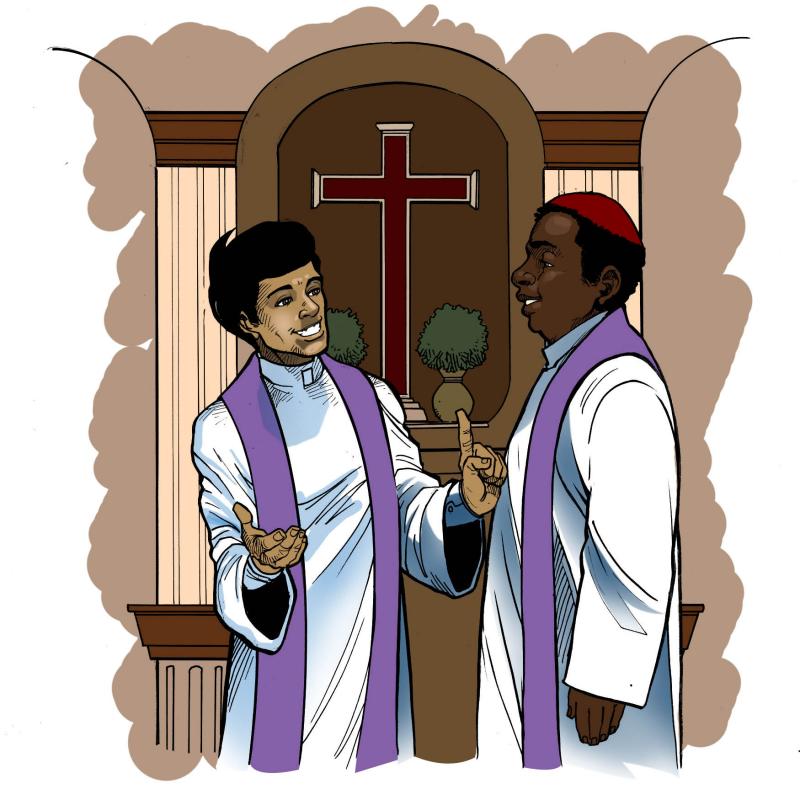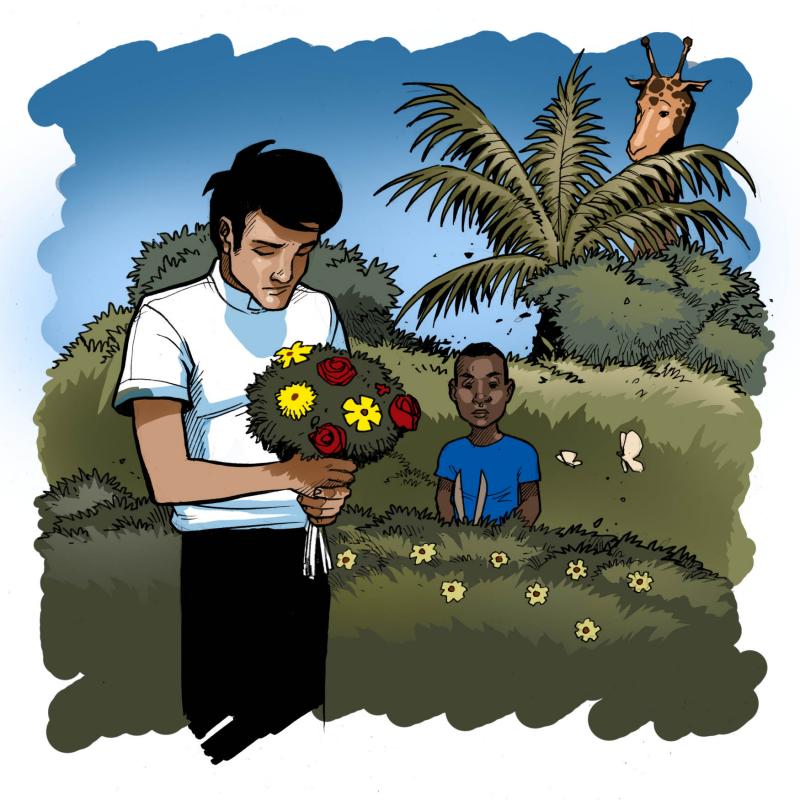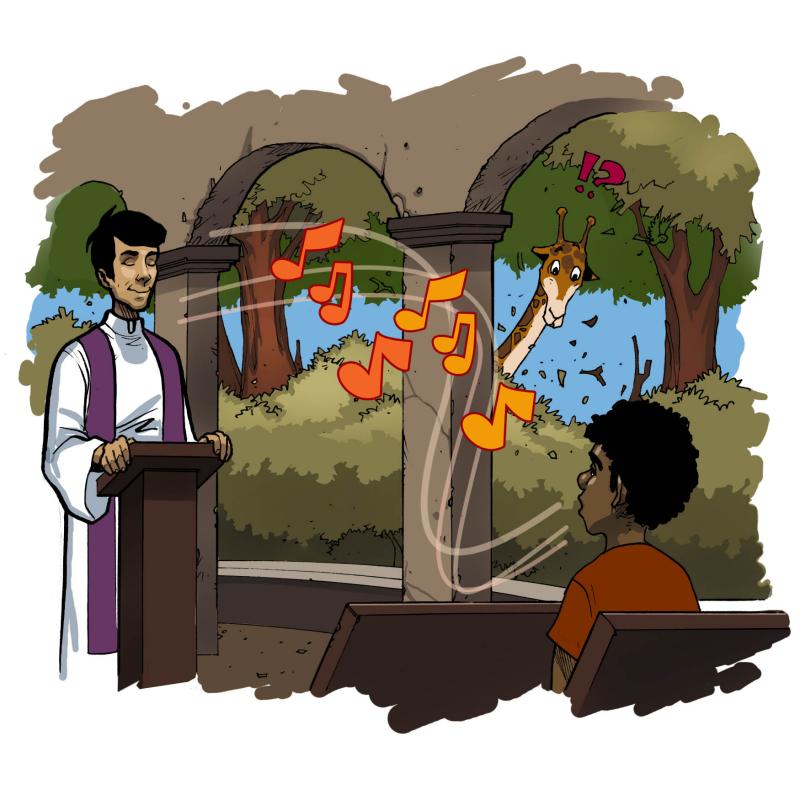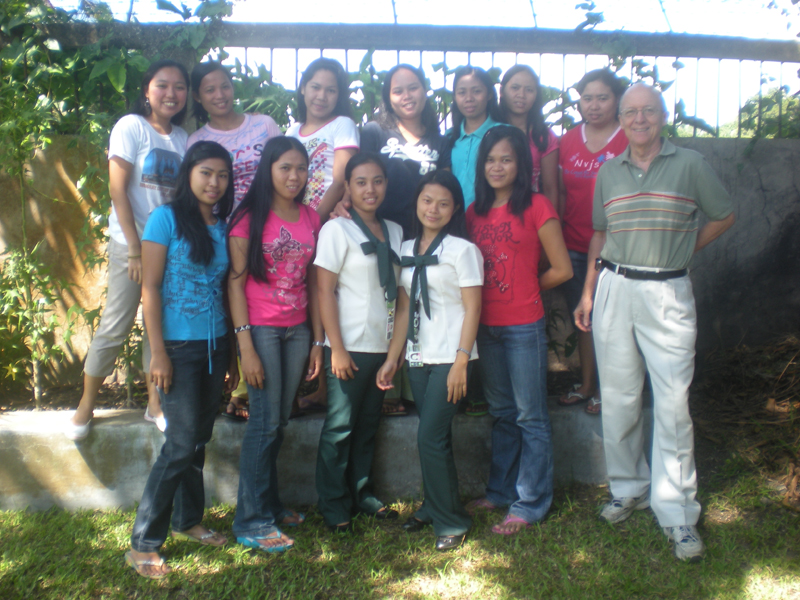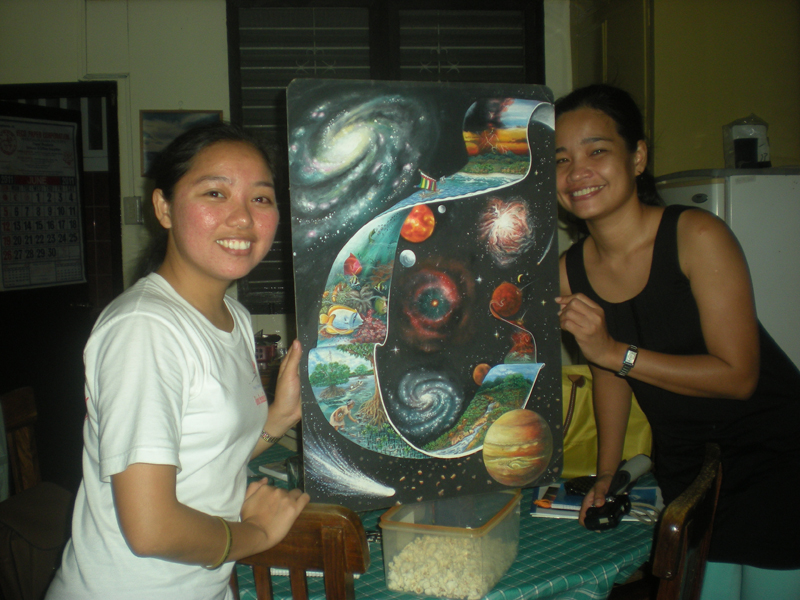Misyon Online - November-December 2012
Pulong ng Editor
I Heard the Bells on Christmas Day
By Henry Wadsworth Longfellow
Sr Rhea Lei quotes American poet Henry Wadsworth Longfellow (1802 – 1887). One of his poems, Christmas Bells, has become a very popular Christmas carol in the USA, with different musical settings. Here is one of them.
Christmas with Jesús
By Fr Alo Connaughton
The author is one of two brothers who are Columbans. His older brother Father Sean worked in the Philippines for many years, in Zambales and Manila. Father Alo spent his early years as a priest in Chile.
 The first thing I need to clarify is that the Jesús I’m talking about is from Madrid and his family names are Galeote Tormo; and of course his name is pronounced ‘heSUS’. He is a doctor who got his degrees in medicine from the University of Salamanca; and he is a Franciscan priest. He has 17 years of medical practice in rural Bolivia behind him, seven of those as a hospital director.
The first thing I need to clarify is that the Jesús I’m talking about is from Madrid and his family names are Galeote Tormo; and of course his name is pronounced ‘heSUS’. He is a doctor who got his degrees in medicine from the University of Salamanca; and he is a Franciscan priest. He has 17 years of medical practice in rural Bolivia behind him, seven of those as a hospital director.
Were they difficult years? He remembers especially the tension involved in carrying out late-night emergency caesarean sections with the help of two local assistants he had trained and using power from a gasoline generator. In all these cases, day or night, he had to do everything himself, including anesthetics.
In the remote area where he worked these were matters of life or death; no other help was available. When help did become available and Bolivia began to supply its own doctors and medical staff to rural areas Father Jesús decided to respond to a request by the Franciscan superiors for volunteers for Thailand.
Following in Father Pat’s footsteps
By Siobhan McCaffrey
Fr Pat McCaffrey, from County Fermanagh, Northern Ireland, died suddenly in Pakistan on 18 May 2010. He had served first as a Columban missionary in Fiji before joining the pioneering group of Columbans that went to Pakistan in 1979. Later he spent some years in Britain, based in Bradford, where there are many people of Pakistani origin. He was involved with Muslims there and celebrated Mass regularly with Catholic Pakistanis. He returned to Fiji but was to spend his late years in Pakistan. Here his niece writes about her visit, with her brother Niall. This article was published in The Far East, the Columban magazine in Australia and New Zealand.
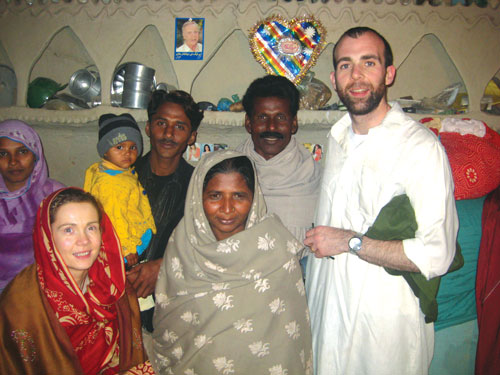
My uncle, Columban missionary Fr Patrick (Pat) McCaffrey, died in Pakistan on 18 May 2010. His sudden and untimely death meant that no family members from home in Ireland were able to attend his funeral. My brother Niall and I therefore decided to make a pilgrimage to Pakistan over Christmas 2010 to follow in our Uncle Pat’s footsteps.
We arrived at Karachi airport in the early hours of 19 December 2011 and were met by Columban Fr Tomás King. He was to be our host, driver, guide and interpreter, along with Annette Menzes, a good friend of Father Pat’s. We then travelled to the parish of Matli in the Sindh Province where Father Pat had ministered from 1984 to 1994. It was here that he had initiated a housing scheme for parishioners from outlying areas to build their homes on church land in the town. We visited many of these homes that ranged from sturdy brick constructions to basic one-room mud huts.
Joy in Service
By Vissia Hernandez
The Missionaries of Charity is a Catholic religious congregation founded in 1950 by an Albanian-born, Indian Catholic nun who dedicated her life ministering to ‘the unwanted, the unloved, the uncared for’ from the slums of Kolkata, India, to missions across six continents. In 2003, she was beaitified by Pope John Paul II as Blessed Teresa of Kolkata.
In addition to the religious vows of chastity, poverty and obedience, Missionaries of Charity take a fourth vow, to give ‘wholehearted and free service to the poorest of the poor’.
I was a bit hesitant and concerned as I began my interview with Sister Ligaya MC in the Missionaries of Charity’s Formation House in Tayuman St, Tondo, Manila. But an hour later, I came away blessed from a most inspiring encounter.
In June 1990, a car accident in Pakistan left the newly professed missionary from Davao severely brain-damaged. That Sister Ligaya miraculously survived and continues to faithfully and (like her name, the Tagalog for ‘joy’ or ‘happiness’) joyfully serve the poor, the sick and the dying, are testaments to the Lord’s Divine Mercy and the industrial-strength faith and devotion of her MC Sisters and their beloved foundress.
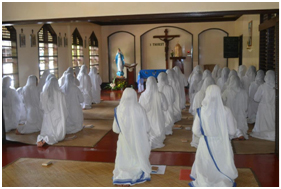 In her blue-edged, white sari, Sister Ligaya serenely blends with almost a hundred similarly-swathed Sisters and postulants in the Formation House. But the moment she speaks, the extent of her 22-year old injuries becomes painfully evident. Every strangled word is accompanied by spasms, involuntary jerky movements and urgent gasps for air. I apologized and wanted to call off our interview immediately, but she assured me she was fine and wished to go on. And so for an hour, we conducted our interview: partly in guttural whispers, partly in jerky mime, and several times, with Sister Ligaya patiently writing down her answers in my notebook. This is her story.
In her blue-edged, white sari, Sister Ligaya serenely blends with almost a hundred similarly-swathed Sisters and postulants in the Formation House. But the moment she speaks, the extent of her 22-year old injuries becomes painfully evident. Every strangled word is accompanied by spasms, involuntary jerky movements and urgent gasps for air. I apologized and wanted to call off our interview immediately, but she assured me she was fine and wished to go on. And so for an hour, we conducted our interview: partly in guttural whispers, partly in jerky mime, and several times, with Sister Ligaya patiently writing down her answers in my notebook. This is her story.
The Emptiness Within
By Sr Rhea Lei Y. Tolibas TC
Life has its own amazing and extraordinary story, from the day we’re born until the day when we are gone but as Longfellow’s poem goes, ‘the grave is not its goal’.
TELL me not, in mournful numbers,
Life is but an empty dream ! —
For the soul is dead that slumbers,
And things are not what they seem.
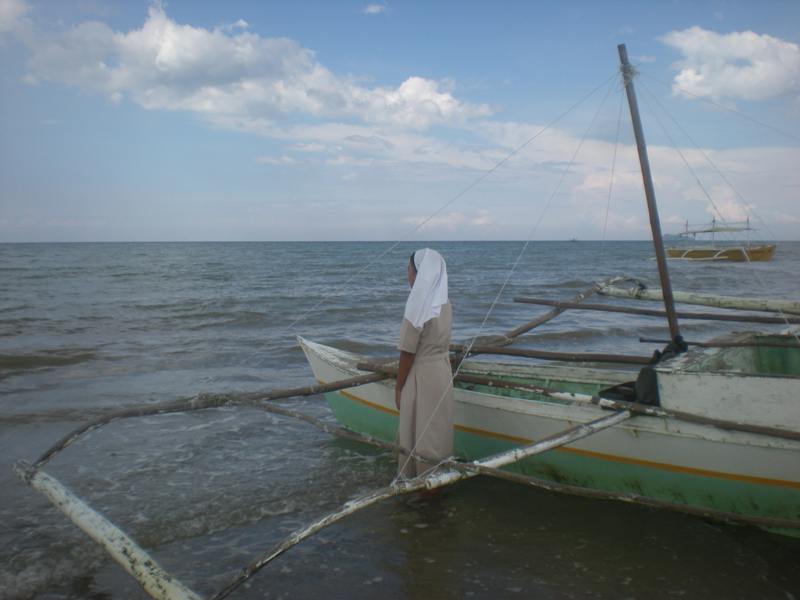 Life has an innate search for meaning, satisfaction, and for true happiness. This is the emptiness within that most of us are perhaps unaware of in a way that we are being misled to look for these in worldly desires and satisfactions such as material wealth, power, lust and possessions. But behind all these is the deep yearning for God.
Life has an innate search for meaning, satisfaction, and for true happiness. This is the emptiness within that most of us are perhaps unaware of in a way that we are being misled to look for these in worldly desires and satisfactions such as material wealth, power, lust and possessions. But behind all these is the deep yearning for God.
When I was a child, simple things could make me happy: when my father came home from work with something for me, when my mother bought me a new dress, when my sisters gave me a candy. These brought a simple, temporary happiness. I never knew what happiness could really mean. I was thinking true happiness is only for those who are well off, who never suffer. I grew up in a poor family. I hated poverty, since it made us suffer, made my mother cry often, made my parents sacrifice so much. As children we never knew how to play as other children did. We needed to work hard and to sacrifice even if sometimes we could play.
Few of us like to suffer. We see suffering as pain, with no happiness or satisfaction. We don’t know how to embrace it with joy.
Vocation ‘re-Creation’
By Mary Joy Rile
 I was awakened one morning in awe by a flashback of my childhood dream of becoming an astronomer. I loved the study of the planets, the universe, and all heavenly bodies in my elementary years. Then followed my recollection of Fr Vinnie’s sharing the day before on the birth of the universe with the Big Bang Theory, leading to our own births. In a sense we all have the same birth through the call of God when he declared Jesus to be the Savior of the world. Was the universe truly working on births and dates and on how we all started to live in it?
I was awakened one morning in awe by a flashback of my childhood dream of becoming an astronomer. I loved the study of the planets, the universe, and all heavenly bodies in my elementary years. Then followed my recollection of Fr Vinnie’s sharing the day before on the birth of the universe with the Big Bang Theory, leading to our own births. In a sense we all have the same birth through the call of God when he declared Jesus to be the Savior of the world. Was the universe truly working on births and dates and on how we all started to live in it?
We’re used to reading vocation stories where people tell us how the Call started, what the manifestations were and how they live the Call. But Anne Gubuan, the assistant editor, and I were to see vocation from a different perspective when we went to visit Fr Vincent Busch in Ozamiz City. The encounter started with corn being popped, coffee being brewed and a few jokes. It then went on to Fr Vinnie’s many stories, each seemingly different from the others but all coming together to weave a cohesive web.
Fr Vinnie shared that creation is a gift from God and mission is about expanding your point of view to include all creatures. He portrayed this on the recently released Christmas cards made by Subanen Crafts. His book Ang Damgo sa Mindanao (The Dream of Mindanao) with few words but many illustrations expresses the great concern of Mindanao. How he interconnected each painting in the book was very interesting.
I was glad to learn as well of his Creation Mandala. Drawn in abstract style, the symbols intrigued me because of the meaning behind every piece. I was to know from Fr Vinnie that a circle is a mandala in itself! The designs and his poetry, the meaning behind each painting and even the size of a mandala fitting the drawing were striking. He showed us his first mandala though when he created it he didn’t know the Sanskrit word, which means ‘circle’.
Woman - behold thy Son
By Gloria Greganda
The author, from Calamba, Laguna, returned home this year after having worked for 25 years in Hong Kong. This article first appeared in the Mabuhay section of Sunday Examiner, the English-language weekly of the Diocese of Hong Kong.
I am always struck by the thought of what Mary, the mother of Jesus, experienced as she watched her Son being crucified. I always imagine her pain. Her anguish over her Son’s suffering must be really incomparable.
This reminds me of when my daughter gave birth. As I watched her suffer the labor pains, I wanted to take away her pain and bear it myself, so she would not suffer—how much more Mary, whose Son died before her very eyes. Truly, a mother’s endurance is worth admiring.
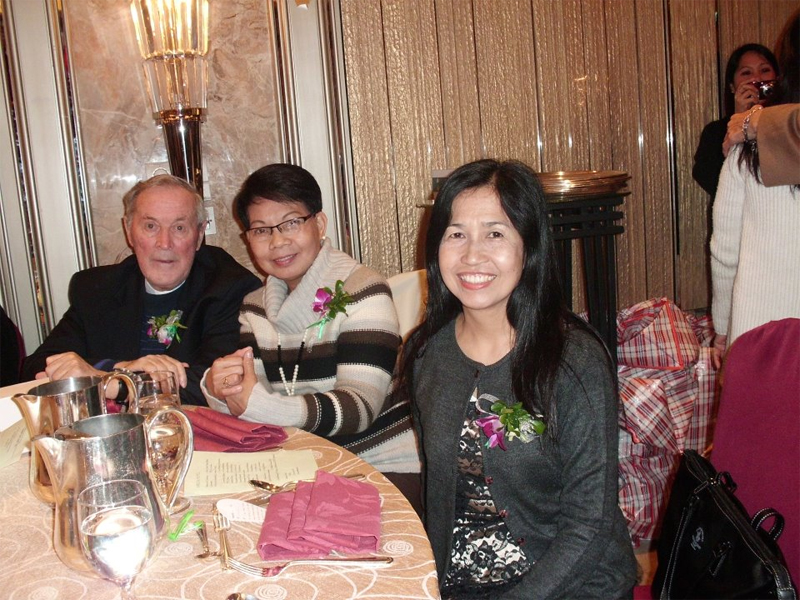
In the world we live in, many stories have come and gone, stories about mother and child, some very touching and moving, some painful and some inspiring.
As migrant mothers, we too have our share of ups and downs whether in work or in personal life.
Bangon Cagayan
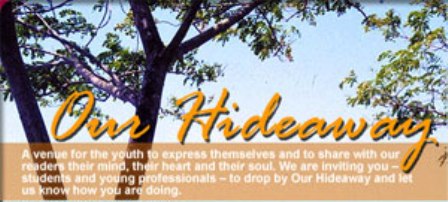
By Erl Dylan J. Tabaco
The author, a Columban seminarian, writes about the disaster that hit his native Cagayan de Oro City, Mindanao, last December. He has appeared a number of times in Misyon, most recently in the January-February 2012 issue, Revitalizing the Church: Bringing the Gospel to the Deaf.
While on my way to the airport for my afternoon flight back to Manila, I saw a big streamer with the words ‘Bangon Cagayan’ (‘Arise Cagayan’). This mirrored the sad faces of many in Cagayan de Oro City (CDO) where severe tropical storm Sendong (international name: ‘Washi’) had struck a number of barangays (administrative districts) in the city during the night of 16-17 December last year. It took the lives of hundreds of people and caused much damage to infrastructures and property.
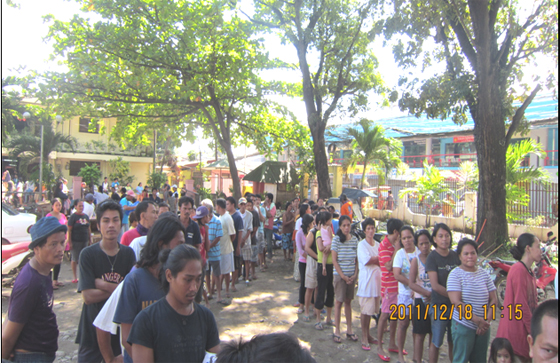
On the other hand, the streamer encouraged people to remember that there is always hope amidst despair. I recalled my own experience that night. In my 25 years I had never experienced that kind of catastrophe. It was beyond my imagination.

November – December 2012
May the God of Peace make you holy and bring you to perfection. May you be completely blameless, in spirit, soul and body, till the coming of Christ Jesus, our Lord.
~ 1 Thessalonians 5:23 ~
The ‘door of faith’ (Acts 14:27) is always open for us, ushering us into the life of communion with God and offering entry into his Church. It is possible to cross that threshold when the word of God is proclaimed and the heart allows itself to be shaped by transforming grace. To enter through that door is to set out on a journey that lasts a lifetime. It begins with baptism (cf. Rom 6:4), through which we can address God as Father, and it ends with the passage through death to eternal life, fruit of the resurrection of the Lord Jesus, whose will it was, by the gift of the Holy Spirit, to draw those who believe in him into his own glory (cf. Jn 17:22). To profess faith in the Trinity – Father, Son and Holy Spirit – is to believe in one God who is Love (cf. 1 Jn 4:8): the Father, who in the fullness of time sent his Son for our salvation; Jesus Christ, who in the mystery of his death and resurrection redeemed the world; the Holy Spirit, who leads the Church across the centuries as we await the Lord’s glorious return.
~ PORTA FIDEI, Apostolic Letter of the Supreme Pontiff Benedict XVI for the Indiction of the Year of Faith ~
German stamp in honor of Pope Benedict XVI 2007
It is an error to isolate oneself from men . . . If God does not call one to solitude, one must live with God in the multitude, make him known there and make him loved.
~ Raissa Maritain, Poet and Contemplative (1883 – 1960) ~
Video on Jacques and Raissa Maritain
Pulong ng Editor
Pulong ng Editor
By Fr Sean Coyle
Christmas with Jesús
By Fr Alo Connaughton
The author is one of two brothers who are Columbans. His older brother Father Sean worked in the Philippines for many years, in Zambales and Manila. Father Alo spent his early years as a priest in Chile.
 The first thing I need to clarify is that the Jesús I’m talking about is from Madrid and his family names are Galeote Tormo; and of course his name is pronounced ‘heSUS’. He is a doctor who got his degrees in medicine from the University of Salamanca; and he is a Franciscan priest. He has 17 years of medical practice in rural Bolivia behind him, seven of those as a hospital director.
The first thing I need to clarify is that the Jesús I’m talking about is from Madrid and his family names are Galeote Tormo; and of course his name is pronounced ‘heSUS’. He is a doctor who got his degrees in medicine from the University of Salamanca; and he is a Franciscan priest. He has 17 years of medical practice in rural Bolivia behind him, seven of those as a hospital director.
Were they difficult years? He remembers especially the tension involved in carrying out late-night emergency caesarean sections with the help of two local assistants he had trained and using power from a gasoline generator. In all these cases, day or night, he had to do everything himself, including anesthetics.
In the remote area where he worked these were matters of life or death; no other help was available. When help did become available and Bolivia began to supply its own doctors and medical staff to rural areas Father Jesús decided to respond to a request by the Franciscan superiors for volunteers for Thailand.
I had the pleasure of spending Christmas two years ago with him in the far north of Thailand, in Chiang Saen in the ‘Golden Triangle.’ This is the area along the banks of the Mekong River where Thailand, Burma and Laos meet. I had a special interest in accepting his invitation. Many of the students I teach in Bangkok come from the north of the country and I like to take any opportunity I can to get to know their background - even if it involves an almost 1,000km bus journey.
The previous year I was in the western part of the Diocese of Chiang Mai, also along the Burmese border, in the province of Mae Hong Son. Some people in one village were mildly complaining that the parish priest rarely showed up; he usually sent the assistant.
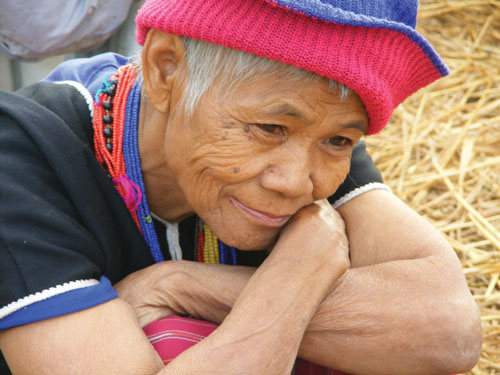 When I made further enquiries I’ll admit I had some sympathy for the pastor. He is advanced in years and not so good on his feet. It had taken me three hours to walk up the mountains to get to the village. The real knockout came when I asked how far away the parish house was - about 200kms!
When I made further enquiries I’ll admit I had some sympathy for the pastor. He is advanced in years and not so good on his feet. It had taken me three hours to walk up the mountains to get to the village. The real knockout came when I asked how far away the parish house was - about 200kms!
The parish had 40 chapels. On that visit last year I could see no evidence that the limited pastoral attention to the area was leading to indifference. About 2,000 villagers from the hills sat under the moonlight to celebrate that Christmas Night Mass on December 24. Some of them had walked for the whole day to get there.
But let us go back to Chiang Saen. Here the Christian communities are smaller but growing. It's known as ‘hill tribe area.’ Father Jesús, on his motorbike, visited villages which have been there for many generations. The people are from different ethnic groups and there are seven different languages in common use in the parish - Thai, Burmese, Karen, Akha, Lahu, Lisu and Yao.
Many of these groups trace their roots back to China or Tibet. Fortunately most of the middle aged and all of the young understand Thai. Father Jesús still gives some medical attention but services are available in Thailand and he refers all cases of a more serious nature to a Thai doctor or to the hospital.
In this part of Thailand, where Christmas is not a big national event, the celebration takes place for these isolated communities whenever a priest is available to celebrate the Christmas Mass. It can happen any time between 23 December and New Year’s Day. The four ‘Christmases’ I attended during the six days I was there were all happy events and celebrated with the same enthusiasm as if it was ‘the real’ Christmas Day.
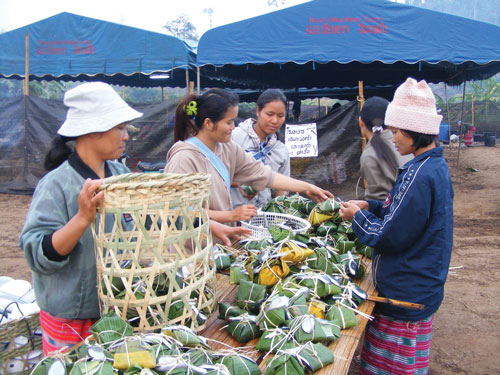 It occurred to me that maybe in fact they were more aware of what was real and important about Christmas, even if they were celebrating it on 29 December. The celebration wasn’t just limited to Mass. There were games before and after, food eaten around bonfires, and gifts for everyone. Most of these were provided by pooling the simple gift that each person brought and then having a re-distribution by means of a free raffle.
It occurred to me that maybe in fact they were more aware of what was real and important about Christmas, even if they were celebrating it on 29 December. The celebration wasn’t just limited to Mass. There were games before and after, food eaten around bonfires, and gifts for everyone. Most of these were provided by pooling the simple gift that each person brought and then having a re-distribution by means of a free raffle.
The people of these villages don’t have much in material terms but what they do have in abundance is an extraordinary attention and reverence when they come together to celebrate the Eucharist. And there are other things like a real sense of excitement at the prospect of a small gift, and the ability to join with hilarity in the simplest of games. These are things that many of their more sophisticated brethren in other parts of the world lost a long time ago.
These two Christmases were simple, but on both occasions as I made my way back to Bangkok I felt that I had seen with my own eyes the ways in which what is celebrated at Christmas can really be experienced as ‘good news for the poor.’
Fr Connaughton was the previous editor of Far East, the Columban magazine in Ireland and Britain. This article appeared in The Far East, the Columban magazine in Australia and New Zealand.
Father Joeker

By Fr Joseph Panabang SVD
Beaming from ear to new Bishop Dominic Nyarko Yeboah of Techiman, with whom I had spent my pastoral year, was giving me the sign of peace. ‘You are lucky I refused or else you would never have become a bishop,’ I whispered and that sent him thundering in laughter.
At the Benedictine Monastery in Techiman, Ghana, I was digging up the flowers when the bell for the Angelus rang. I froze to a stop and prayed the Angelus while a worker, not a Catholic, watching in rapt attention, was really impressed. I was narrating the incident later in the monastery and concluded proudly, ‘If that worker is converted to Catholicism, I am responsible’. ‘He was not impressed; he was scandalized to see you praying while stealing the flowers,’ said Father Giles, a monk from England, in disagreement.
At Kintampo Waterfalls, which I converted into a prayer park, I used stone for the walls, rock gardens, tables and seats. While the people were praising the unique artifact, Fr Victor Leones SVD from Abra, the only remaining Filipino SVD pioneer missionary to Ghana, chimed in, ‘Hey, his and my ancestors built the famous Banaue Rice Terraces in the Philippines – one of the wonders of the world’.
One morning only a ten-year-old boy, Eric Tettey, attended my daily Mass at the center here in Osonson. He sang a beautiful entrance song so soulfully and since it was in Krobo, a dialect of the Krobo people in Eastern Ghana, I could only hum. I was touched and felt that an angel had come down to attend the Mass.
Following in Father Pat’s footsteps
By Siobhan McCaffrey
Fr Pat McCaffrey, from County Fermanagh, Northern Ireland, died suddenly in Pakistan on 18 May 2010. He had served first as a Columban missionary in Fiji before joining the pioneering group of Columbans that went to Pakistan in 1979. Later he spent some years in Britain, based in Bradford, where there are many people of Pakistani origin. He was involved with Muslims there and celebrated Mass regularly with Catholic Pakistanis. He returned to Fiji but was to spend his late years in Pakistan. Here his niece writes about her visit, with her brother Niall. This article was published in The Far East, the Columban magazine in Australia and New Zealand.

My uncle, Columban missionary Fr Patrick (Pat) McCaffrey, died in Pakistan on 18 May 2010. His sudden and untimely death meant that no family members from home in Ireland were able to attend his funeral. My brother Niall and I therefore decided to make a pilgrimage to Pakistan over Christmas 2010 to follow in our Uncle Pat’s footsteps.
We arrived at Karachi airport in the early hours of 19 December 2011 and were met by Columban Fr Tomás King. He was to be our host, driver, guide and interpreter, along with Annette Menzes, a good friend of Father Pat’s. We then travelled to the parish of Matli in the Sindh Province where Father Pat had ministered from 1984 to 1994. It was here that he had initiated a housing scheme for parishioners from outlying areas to build their homes on church land in the town. We visited many of these homes that ranged from sturdy brick constructions to basic one-room mud huts.
Many of the people we met remembered Father Pat with great affection and gratitude, as they had him to thank for their home. They were no longer bonded to a land owner. Many of the people disappeared into their houses only to reappear with the memorial picture of Father Pat. His great legacy is in Matli. ‘He should have been buried here’, said one lady.
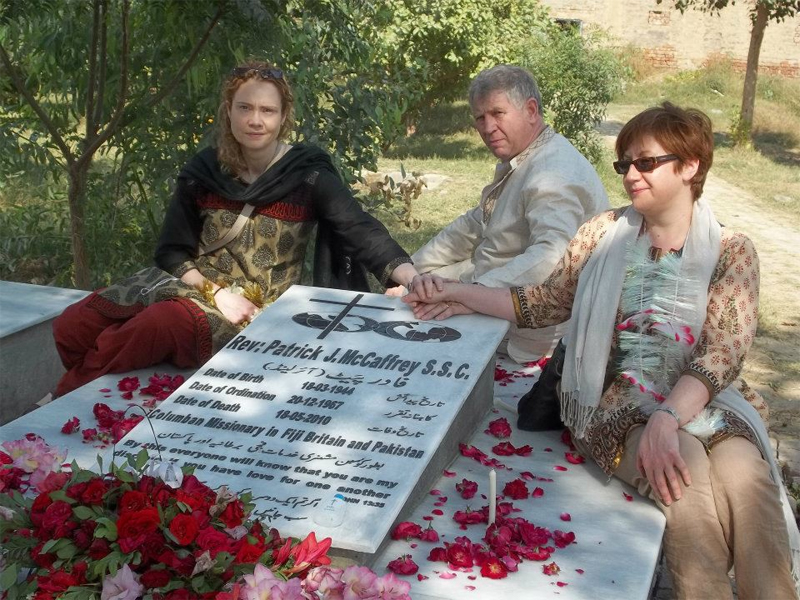
Siobhan at her Uncle Pat’s grave
Another lady we met was Sr Annalisa Samuel. She had worked with Father Pat in Matli during his ten years there. She told us many stories about his selflessness and how he was ‘always ready to be with the people’, bringing them closer to God, taking the sick to hospital, educating poor children and making provision for their needs. She also commented how ‘he never cared for his health’.
When Father Pat returned to Pakistan in 2009, he was appointed to Greentown Parish in Lahore. From Matli we travelled to Lahore on Christmas Eve and attended Midnight Mass there. Father Pat had celebrated Midnight Mass here just two years previously. There we met Father Pat’s colleague, Fr Liam O’Callaghan, who is parish priest in Greentown.
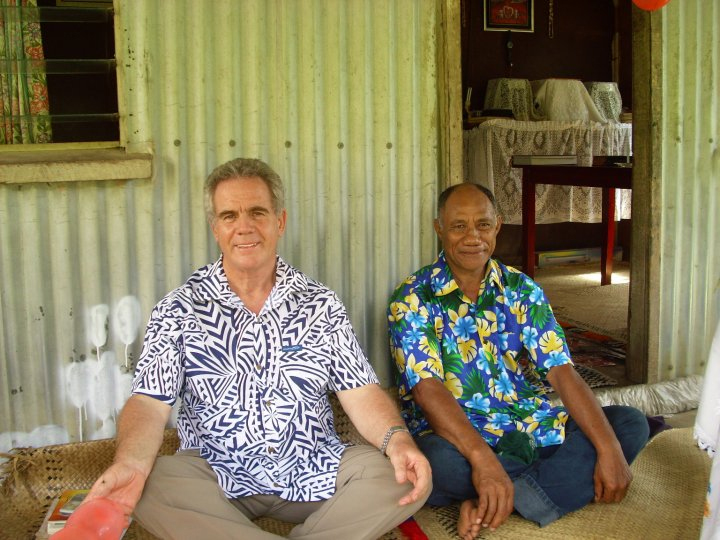
Father Pat and friend in Ba, Fiji
After Midnight Mass we were overwhelmed by the welcome we received. Everyone spoke so highly of Father Pat and also of how deeply they missed him. On Christmas morning, we visited his grave, a beautiful spot under a large tree behind the Church compound in Greentown. Alongside our uncle's grave was that of his colleague, Fr Tommy O’Hanlon, from County Kerry, Ireland, who died in Lahore 19 days after Father Pat. It was very poignant to see the two graves and it was also a very emotional experience for both of us, being the first family members to visit since his death.
We followed the lovely Pakistani practice of lighting candles and incense sticks and arranged them on both graves. For us, Father Pat’s faraway family, it is such a comfort that the graves are so lovingly kept by the parishioners. As his family, we were aware of his wishes to ‘die with his boots on’ and to be buried among the people to whom he had dedicated his life.
We visited his grave for the final time on our last day in Lahore, just as the sun was beginning to set. It was hard to walk away. What made it easier, for me at least, was that when we had arrived at the grave that evening, there was already a candle burning on Father Pat’s grave. He will not be forgotten in Greentown.
On our last day, we travelled to the town of Murree, a seven hour drive from Lahore, situated on the side of a steep hill, in the foothills of the Himalayas. Murree was where Father Pat died. He had been visiting lay missionaries there. He had left the convent around 6:00am to catch a bus to Rawalpindi. He was rushing to catch the bus when he died. The only person around was a street-sweeper, considered the lowest of the low in Pakistan’s caste system.
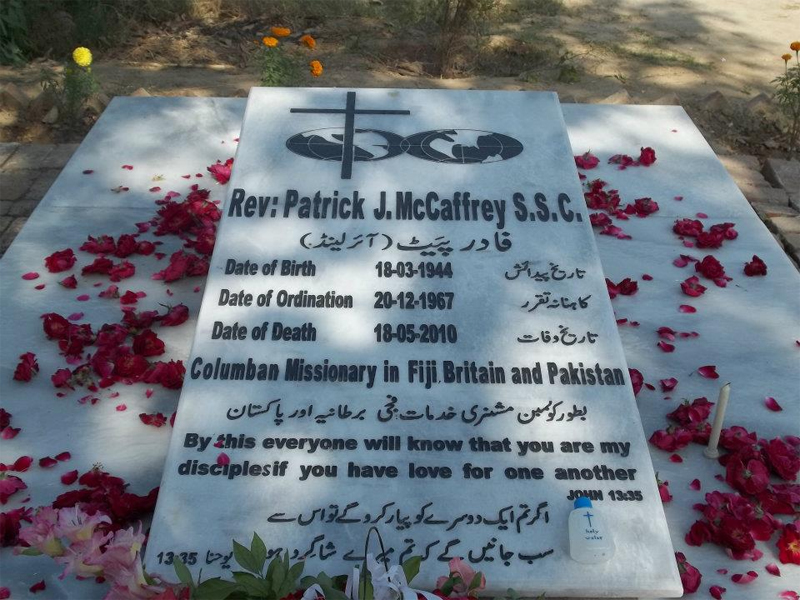
Father Pat's Grave
This man had seen Father Pat holding on to the rails outside the compound and then fall back onto the road. He went to his aid but was unable to help. He raised the alarm at the convent and the Sisters came.
We thanked the street-sweeper for trying to help our uncle. He apologized for not being able to save him and explained that it was his moral duty to try, but that God had decided to take him and there was nothing he could do.
Our ‘pilgrimage’ to Pakistan has been an amazing, unforgettable experience. We have many, many memories to treasure; of a beautiful country, its resilient people and of the warm welcome we received. We have also come away with a deeper understanding of our uncle’s calling and what it was that drew him back to Pakistan. He had requested this, his final posting.
A final word of thanks to all the Columbans in Pakistan who made us so welcome and went out of their way to ensure we truly were able to follow in Father Pat’s footsteps.
I Heard the Bells on Christmas Day
By Henry Wadsworth Longfellow
Sr Rhea Lei quotes American poet Henry Wadsworth Longfellow (1802 – 1887). One of his poems, Christmas Bells, has become a very popular Christmas carol in the USA, with different musical settings. Here is one of them.
Joy in Service
By Vissia Hernandez
The Missionaries of Charity is a Catholic religious congregation founded in 1950 by an Albanian-born, Indian Catholic nun who dedicated her life ministering to ‘the unwanted, the unloved, the uncared for’ from the slums of Kolkata, India, to missions across six continents. In 2003, she was beaitified by Pope John Paul II as Blessed Teresa of Kolkata.
In addition to the religious vows of chastity, poverty and obedience, Missionaries of Charity take a fourth vow, to give ‘wholehearted and free service to the poorest of the poor’.
I was a bit hesitant and concerned as I began my interview with Sister Ligaya MC in the Missionaries of Charity’s Formation House in Tayuman St, Tondo, Manila. But an hour later, I came away blessed from a most inspiring encounter.
In June 1990, a car accident in Pakistan left the newly professed missionary from Davao severely brain-damaged. That Sister Ligaya miraculously survived and continues to faithfully and (like her name, the Tagalog for ‘joy’ or ‘happiness’) joyfully serve the poor, the sick and the dying, are testaments to the Lord’s Divine Mercy and the industrial-strength faith and devotion of her MC Sisters and their beloved foundress.
 In her blue-edged, white sari, Sister Ligaya serenely blends with almost a hundred similarly-swathed Sisters and postulants in the Formation House. But the moment she speaks, the extent of her 22-year old injuries becomes painfully evident. Every strangled word is accompanied by spasms, involuntary jerky movements and urgent gasps for air. I apologized and wanted to call off our interview immediately, but she assured me she was fine and wished to go on. And so for an hour, we conducted our interview: partly in guttural whispers, partly in jerky mime, and several times, with Sister Ligaya patiently writing down her answers in my notebook. This is her story.
In her blue-edged, white sari, Sister Ligaya serenely blends with almost a hundred similarly-swathed Sisters and postulants in the Formation House. But the moment she speaks, the extent of her 22-year old injuries becomes painfully evident. Every strangled word is accompanied by spasms, involuntary jerky movements and urgent gasps for air. I apologized and wanted to call off our interview immediately, but she assured me she was fine and wished to go on. And so for an hour, we conducted our interview: partly in guttural whispers, partly in jerky mime, and several times, with Sister Ligaya patiently writing down her answers in my notebook. This is her story.
They were crossing an intersection, on their way home from the Don Bosco Home for Boys in Karachi, after a week of teaching Hindu children the basics of reading and writing, when a bus rammed her side of the van, throwing her out of the vehicle and smashing her head against the tarmac.
Sister Ligaya immediately lapsed into a coma as her brain swelled and started hemorrhaging. When the doctors, suspecting brain stem injury, advised her superior that she was beyond hope, her superior hastened back to their community and had the Blessed Sacrament exposed for a 24-hour vigil. She then ordered the Sisters to fast for Sister Ligaya’s recovery. After three weeks, Sister Ligaya woke up from her coma, in pain, unable to speak or see clearly, but with her mental faculties intact – the first miracle.
On her way back to the Philippines for further treatment, she was brought to the  Mother House in Kolkata for a blessing. As they laid her on Mother Teresa’s bed, she remembered that Mother was present during her first profession. The year before, Mother blessed her as she was starting her new mission to serve the sick and the dying. Now, Mother was praying over her again, as she lay sick and possibly dying. And then it happened - her vision, blurred since the accident, suddenly cleared up as she beheld the beloved lined face of their Superior General, smiling kindly at her – the second miracle.
Mother House in Kolkata for a blessing. As they laid her on Mother Teresa’s bed, she remembered that Mother was present during her first profession. The year before, Mother blessed her as she was starting her new mission to serve the sick and the dying. Now, Mother was praying over her again, as she lay sick and possibly dying. And then it happened - her vision, blurred since the accident, suddenly cleared up as she beheld the beloved lined face of their Superior General, smiling kindly at her – the second miracle.
For the past 20+ years, Sister Ligaya has been a miracle-in-progress, not so much for her remarkable recovery, but more so for her joyful and unbroken spirit. In time, she walked again and cheerfully took on increasing responsibilities in the Formation House: helping prepare the sanctuary for Mass, planning the activities and lessons for the catechists, assisting in the kitchen and eventually heading the kitchen. For ten years, she planned and supervised the preparation of inexpensive yet tasty and nutritious meals for over 90 patients in the Home for the Dying, an MC institution which provides free hospice care.
There was only one more interview question remaining. Sister Ligaya somehow sensed it and talked about the source of her obvious joy. She wrote in my notebook, ‘I was so touched by the life of Blessed Mother Teresa. I also want to face my suffering as a gift of God; it is no longer a suffering, but a real communion with God. In offering it, I honor and glorify Him and all souls. Besides, I would rather suffer here for a while, than much longer in the afterlife’.
I am not used to hearing about the power of fasting and adoration vigils,  healing miracles, and the Christian dimension of suffering, mentioned so matter-of-factly, but coming from a Missionary of Charity, I was not too surprised. After all, about 5000 multinational MCs live with these spiritual realities everyday as they continue Blessed Teresa’s mission of loving service to ‘Christ in distressing disguise’ - the world’s needy in 133 countries and over 450 MC charity centers worldwide.
healing miracles, and the Christian dimension of suffering, mentioned so matter-of-factly, but coming from a Missionary of Charity, I was not too surprised. After all, about 5000 multinational MCs live with these spiritual realities everyday as they continue Blessed Teresa’s mission of loving service to ‘Christ in distressing disguise’ - the world’s needy in 133 countries and over 450 MC charity centers worldwide.
Turning to leave, Sister Ligaya remembered something and whispered, ‘The Dutch nurse, who cared for me when I was comatose in Karachi, became a Missionary; she is now our regional head in Sri Lanka – a miracle from a miracle!’ Smiling, she joined the other white saris in prayer.
Sister Ligaya’s recovery is coming along very well. Please continue to pray for her.
Our Hideaway
Bangon Cagayan

By Erl Dylan J. Tabaco
The author, a Columban seminarian, writes about the disaster that hit his native Cagayan de Oro City, Mindanao, last December. He has appeared a number of times in Misyon, most recently in the January-February 2012 issue, Revitalizing the Church: Bringing the Gospel to the Deaf.
While on my way to the airport for my afternoon flight back to Manila, I saw a big streamer with the words ‘Bangon Cagayan’ (‘Arise Cagayan’). This mirrored the sad faces of many in Cagayan de Oro City (CDO) where severe tropical storm Sendong (international name: ‘Washi’) had struck a number of barangays (administrative districts) in the city during the night of 16-17 December last year. It took the lives of hundreds of people and caused much damage to infrastructures and property.
On the other hand, the streamer encouraged people to remember that there is always hope amidst despair. I recalled my own experience that night. In my 25 years I had never experienced that kind of catastrophe. It was beyond my imagination.
That night I was sleeping comfortably when suddenly I was awakened by a strong wind and rain. The wind was so furious and sounded like a thief trying to destroy our roof. I had no idea what was going on in other areas in the City. I thought that it was just an ordinary typhoon that would just by-pass the city. Flooding didn’t cross my mind knowing that CDO is not prone to it. A few minutes later my sister’s phone rang. It was her officemate asking for help.

I was already nervous and my anxiety increased when a friend in Manila called me and told me that CDO was in a terrible situation. I also spoke to a former classmate and officemate in Manila who was asking for my help because her family was trapped inside their house. I didn’t have access to any news from radio or TV because there was a total black-out. Relying on the information from Manila, I couldn’t imagine how the water level had reached as high as the second-storey of buildings. I was sleepless that night thinking that the Agusan River, connected to the Cagayan River, had also perhaps overflowed.
When morning came Ana Belma H. Flores and Marisol T. Rojas, Columban lay missionaries from Peru, informed me that the family of Ate Lingling, the cook in the convento of Holy Rosary, the Columban parish in Agusan, CDO, was affected by the storm. When we visited her house we saw that most of her things had been damaged. As she narrated what had happened I was moved. She told me that the rising of the water was beyond reach. It was difficult for them to get out of house since the current was too strong. The total black-out added to their difficulty. She thought that these things happened only in the movies. Despite everything, they were blessed that all had survived. As I looked at the neighboring houses, I was really shocked at what I saw. I couldn’t picture a worse situation anywhere else in the city.
It was my first time to see such catastrophic damage. Both banks of the Agusan River had overflowed. Houses as far as 50 meters from the river were all gone. I couldn’t imagine the struggle of the people during that night trying to save their lives and some of their belongings.
Next day John Wang Zhongse and Joseph Li Jiangan, two Chinese Columban seminarians who were visiting, and I we went to San Agustin Cathedral to offer help. We packed relief goods. I was happy to see so many responding to the call of mission as they offered their services for the victims of the storm.
From the Cathedral we went to City Central School, one of the evacuation centers, to deliver the goods that we had prepared. There were many evacuees, from babies a few months old to aging lolos and lolas (grandpas and grandmas). Ironically, what they needed most was water, the element that had taken so many lives and destroyed millions of pesos worth of property. I reflected that we so often take water for granted. We heard so many stories of how victims had struggled confronting the flood. Listening to these I felt daunted about my future work as a priest. In these situations it is very hard to console and advise people especially when they are in the midst of depression thinking that life is meaningless. All I could do was to listen as they expressed their hurt, anxiety and fear. I believe that this was the greatest contribution I could offer.
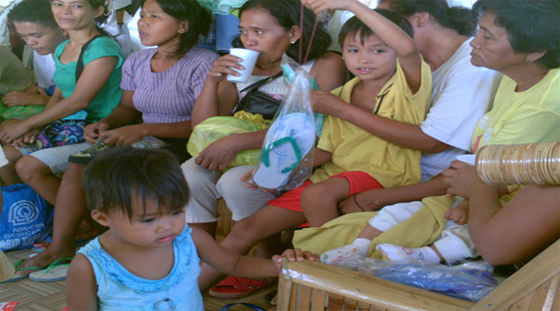
All the Misas de Gallo (the pre-dawn novena of Masses from 16 to 24 December) in the parishes of CDO were offered for the victims and the speedy rehabilitation of the city. In every parish many parishioners gave donations in cash and kind. As a seminarian I found it fulfilling offering myself in helping others. In my own little way I could be part of the journey of those facing another chapter in their lives despite fears, difficulties and brokenness.
It was a very sad Christmas for most people in Cagayan de Oro but it was a wonderful opportunity for us to reflect on the essence of Christmas. Our Savior was born to fulfill God’s plan of salvation. Jesus Christ our Savior emptied himself for our sake as he showed his great love and compassion to humanity. We have also been called to participate in Christ’s mission.
Christmas is a great celebration where we can gather as one family to thank the Lord for his many blessings. It is also a wonderful opportunity for us to give all the glory to him by reaching out others in need. It was indeed a great Christmas celebration for me in a deeper sense. I gave myself much time reflecting on my calling. God is leading me to become the best I can be and to the things that makes me truly happy and fulfilled.
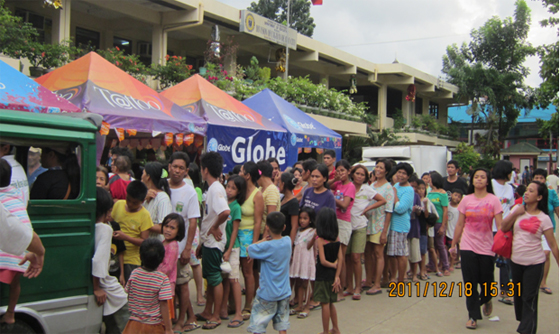
I’m sure that through my serving people God is leading me. Returning to Manila, I brought all these experiences into my discernment process. Bangon Cagayan is a good reminder that there is always hope amid despair. It will drive people to look at life in a positive way despite the many ordeals and difficulties that lie ahead. It is a constant challenge that whatever happens in life, God never fails to love us. We have a God who always strengthens us when we are about to give up because of the circumstances that almost crush us. As the song of Fr Arnel Aquino SJ says, ‘Be not afraid; I am with you, I have saved you, I have called you. You are mine. You are precious to me and I love you. Be not afraid, be not afraid’.
As of now the people of Cagayan de Oro are recovering. Members of many organizations have been supporting them. Agusan Elementary School, where I graduated, was one of the temporary relocation sites. It accommodated residents of Barangay Calacala. Many parishioners visited the families there showing their support to those forced to start a new chapter in their lives. Let us include them in our prayers that they may see light in the midst of darkness. Through the light of Jesus, our beloved brothers and sisters will be comforted and find meaning as they continue on their own journey.
The Emptiness Within
By Sr Rhea Lei Y. Tolibas TC
The author is a Capuchin Tertiary Sister of the Holy Family. Sister Rhea Lei is assigned to Mater Dolorosa Formation House in Talisay City, Negros Occidental.
Life has its own amazing and extraordinary story, from the day we’re born until the day when we are gone but as Longfellow’s poem goes, ‘the grave is not its goal’.
TELL me not, in mournful numbers,
Life is but an empty dream ! —
For the soul is dead that slumbers,
And things are not what they seem.
 Life has an innate search for meaning, satisfaction, and for true happiness. This is the emptiness within that most of us are perhaps unaware of in a way that we are being misled to look for these in worldly desires and satisfactions such as material wealth, power, lust and possessions. But behind all these is the deep yearning for God.
Life has an innate search for meaning, satisfaction, and for true happiness. This is the emptiness within that most of us are perhaps unaware of in a way that we are being misled to look for these in worldly desires and satisfactions such as material wealth, power, lust and possessions. But behind all these is the deep yearning for God.
When I was a child, simple things could make me happy: when my father came home from work with something for me, when my mother bought me a new dress, when my sisters gave me a candy. These brought a simple, temporary happiness. I never knew what happiness could really mean. I was thinking true happiness is only for those who are well off, who never suffer. I grew up in a poor family. I hated poverty, since it made us suffer, made my mother cry often, made my parents sacrifice so much. As children we never knew how to play as other children did. We needed to work hard and to sacrifice even if sometimes we could play.
Few of us like to suffer. We see suffering as pain, with no happiness or satisfaction. We don’t know how to embrace it with joy.
When we encounter people who are suffering we sometimes ask God, ‘Why?’ We even question God’s mercy and love when the world seems unfair and we can’t understand.
In many ways the nature of man is to escape from pain, avoid difficulties and run from problems. We even avoid people we don’t like to run away from reality. Before, whenever I was experiencing struggle and pain I prayed, ‘Lord, why do I need to experience this, take away this pain, I can’t bear it . . . why me?’ How many of us pray this way, a prayer of selfishness and self-centeredness? We become blind to others and choose to ‘carry the world’ on our shoulders.
 Later on I realized that my prayer should be, ‘Lord, thank you for this opportunity to experience pain and suffering. It’s difficult, but thank you for giving me this chance to share in your Passion and death. Grant me the grace to embrace it joyfully and even amidst this situation may I still be an instrument of your love and mercy. Amen’.
Later on I realized that my prayer should be, ‘Lord, thank you for this opportunity to experience pain and suffering. It’s difficult, but thank you for giving me this chance to share in your Passion and death. Grant me the grace to embrace it joyfully and even amidst this situation may I still be an instrument of your love and mercy. Amen’.
In my younger years, when life was bitter, opportunities were nowhere and I was in deep frustration, I wanted to disappear from this world and even planned to end my life. I asked God why my family had to suffer in so many ways, why such a life. I was thinking happiness could be found when everybody finished their studies and poverty and difficulties would no longer have room in our family. But it wasn’t to be so and I continued to search for true happiness while the emptiness within continued to cry out.
 Humbly I admit that I had a negative view about poverty, suffering, humiliation, frustration, problems. The negative experiences in life were bitter and if I could have vomited them out I would have. But I came to know God more deeply in my life the moment I realized that I wasn’t walking in this life alone. God journeys with me in every situation even when I’m stubborn and doubtful of his presence. He never ceases to love and accompany me.
Humbly I admit that I had a negative view about poverty, suffering, humiliation, frustration, problems. The negative experiences in life were bitter and if I could have vomited them out I would have. But I came to know God more deeply in my life the moment I realized that I wasn’t walking in this life alone. God journeys with me in every situation even when I’m stubborn and doubtful of his presence. He never ceases to love and accompany me.
Since I entered religious life and my formation goes on I’ve discovered that living in poverty, experiencing trials, suffering and humiliation are gifts from God. But how hard it is for us to discover our giftedness! Only by faith can we uncover the innate beauty and meaning in our lives. Science and psychology can’t explain the nature of God’s gifts, but they are made to be experienced by vulnerable beings. They are made to draw us closer to God and to make us realize that God is our all, that we are nothing without God.
It is in poverty that I learn to trust and depend on God. It is in my nothingness that I realize that all comes from God. It is in my weakness that I come to experience that God is my only strength. And it is in my wounds that I experience that I have a great healer and lover.
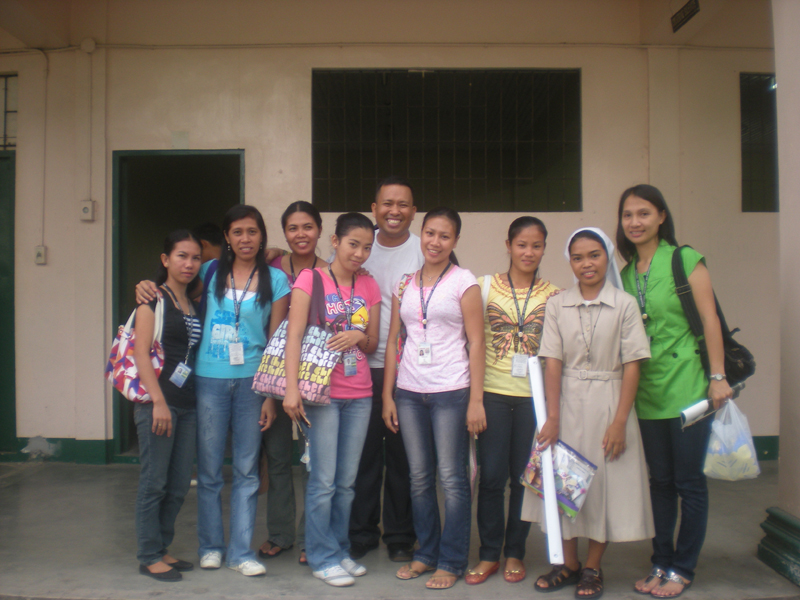 It is there that I found the true meaning of life, I have come to realize that the emptiness of man is God and God alone can satisfy and ease the restlessness of the human heart. It is an innate search and thirst for God. Emptiness will continue to cry out deep within if we can’t find God in our lives. Thus it is in experiencing and having God in every moment that we can find true happiness and satisfaction, not in what the world can offer us. I have experienced that I am loved by God no matter what I have or who I am. This is the most important reality, to discover and experience in one’s life and to respond to that love. Without God in us, everything in this world is empty.
It is there that I found the true meaning of life, I have come to realize that the emptiness of man is God and God alone can satisfy and ease the restlessness of the human heart. It is an innate search and thirst for God. Emptiness will continue to cry out deep within if we can’t find God in our lives. Thus it is in experiencing and having God in every moment that we can find true happiness and satisfaction, not in what the world can offer us. I have experienced that I am loved by God no matter what I have or who I am. This is the most important reality, to discover and experience in one’s life and to respond to that love. Without God in us, everything in this world is empty.
Happiness doesn’t mean the absence of problems, pain, difficulties and humiliations; it is not in having wealth, power, titles, achievements, possessions and other worldly allurements. It is in having God in the midst of our different realities that we can find true happiness. Jesus showed us more than 2000 years ago how to live with poverty, suffering and humiliation, and especially in the ordinary events of life.
Now I’m also discovering how St Francis of Assisi fell in love with ‘Lady Poverty’ and left everything to live in nothingness. It wasn’t just for the sake of a life of poverty but to center his life on God through it. He was after an intimate relationship with God.

St Francis Meditating, El Greco, c.1595 (Web Gallery of Art)
Thus, life can remain one of misery if we can’t find meaning in each day. Trials and difficulties, suffering and pain don’t attract us but if we live with God, for God and in God they will mean more to us than chocolate and ice-cream.
As St Augustine said, ‘For you have made us for yourself and our hearts are restless till they rest in you’.
What really is our deepest desire in life? What or who can make us truly happy? What is our heart really searching for? Are we really fulfilled in our lives now?
It’s never too late to search and discover.
Vocation ‘re-Creation’
By Mary Joy Rile
 I was awakened one morning in awe by a flashback of my childhood dream of becoming an astronomer. I loved the study of the planets, the universe, and all heavenly bodies in my elementary years. Then followed my recollection of Fr Vinnie’s sharing the day before on the birth of the universe with the Big Bang Theory, leading to our own births. In a sense we all have the same birth through the call of God when he declared Jesus to be the Savior of the world. Was the universe truly working on births and dates and on how we all started to live in it?
I was awakened one morning in awe by a flashback of my childhood dream of becoming an astronomer. I loved the study of the planets, the universe, and all heavenly bodies in my elementary years. Then followed my recollection of Fr Vinnie’s sharing the day before on the birth of the universe with the Big Bang Theory, leading to our own births. In a sense we all have the same birth through the call of God when he declared Jesus to be the Savior of the world. Was the universe truly working on births and dates and on how we all started to live in it?
We’re used to reading vocation stories where people tell us how the Call started, what the manifestations were and how they live the Call. But Anne Gubuan, the assistant editor, and I were to see vocation from a different perspective when we went to visit Fr Vincent Busch in Ozamiz City. The encounter started with corn being popped, coffee being brewed and a few jokes. It then went on to Fr Vinnie’s many stories, each seemingly different from the others but all coming together to weave a cohesive web.
Fr Vinnie shared that creation is a gift from God and mission is about expanding your point of view to include all creatures. He portrayed this on the recently released Christmas cards made by Subanen Crafts. His book Ang Damgo sa Mindanao (The Dream of Mindanao) with few words but many illustrations expresses the great concern of Mindanao. How he interconnected each painting in the book was very interesting.
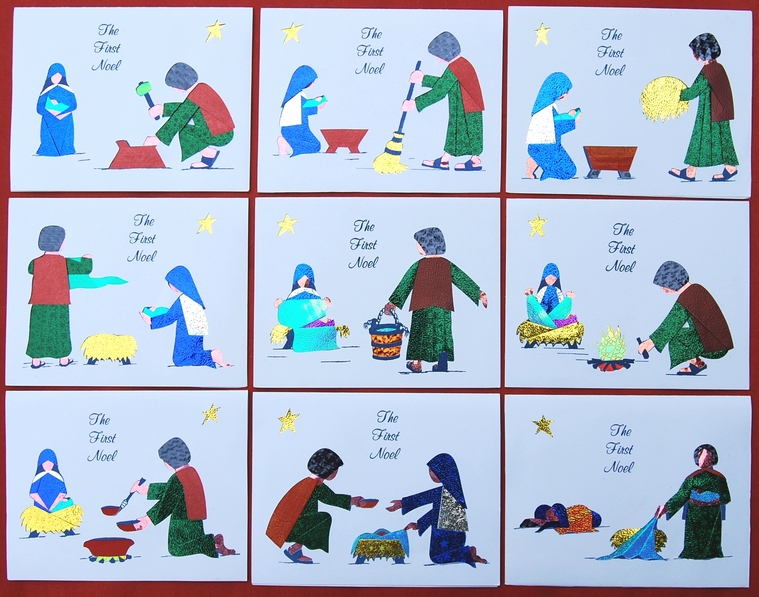
The "First Noel" Cards 2012 by Father Vinnie
I was glad to learn as well of his Creation Mandala. Drawn in abstract style, the symbols intrigued me because of the meaning behind every piece. I was to know from Fr Vinnie that a circle is a mandala in itself! The designs and his poetry, the meaning behind each painting and even the size of a mandala fitting the drawing were striking. He showed us his first mandala though when he created it he didn’t know the Sanskrit word, which means ‘circle’.
He shared about the Creation Rosary emphasizing the role of Mary in salvation. He pointed out that while Mary’s Assumption and Coronation aren’t specifically mentioned in the Bible, that in Matthew 25:35-36, 'For I was hungry and you gave me food, I was thirsty and you gave me drink, I was a stranger and you welcomed me, I was naked and you clothed me, I was sick and you visited me, I was in prison and you came to me,' Jesus is referring to Mary.
Fr Vinnie talked about Creation Spirituality, citing the late Fr Thomas Berry CP, an eco-theologian. My curiosity was truly hooked by this interesting topic, new to me. He spoke of vocation as something related to the work that we do and has nothing to do with our state of life. ‘Are you answering the call of the Spirit, bringing to life God and the universe? You understand a vocation when you see the universe as a gift, not as press materials,’ emphasized Fr Vinnie.
He expounded that the universe is a community of persons not a collection of things. And all things are part of the story of God’s great universe. ‘If you're connected with that, in any way, that's your vocation. Your struggle is to find out what your contribution is to the Great Work.
‘Vocation is also about how we are connected with the liturgy of God in the universe, which we rediscover all the time. Liturgy means “the work of the people”. For example, we don't pull farmers out of their land just to attend Mass. Tending their land has been their expression of celebrating a life with God, and that’s how they’re celebrating the Mass. Spirituality is not about sentimentality. When we remove it from doing then that’s only sentimentality and you take out the real meaning of vocation.’
I was overwhelmed by this. Fr Vinnie’s idea of vocation was new to me. But it was something to make me realize vocation in a deeper context, even closer to the Source. He views things from a different perspective, more connected to valuing Creation. I was amazed at how he put things in continuity, how we are related to one thing and another, demonstrating the web of life. It’s putting meaning in everything there is and in all that we do. For nothing has simply popped up without any purpose at all. It’s the mind of the Great Creator that makes everything meaningful. Reflected in the very mandala of our eyes are all these things, only if we care to see them. And vocation, after all, is not something apart from us, but is within us, since the beginning of our existence.
He showed us a precious painting encompassing all that he shared about creation and vocation. My dream as a young girl, my desire for greater communion with the Creator, my curiosity about life's unfolding miracles and the value of existence, the vocation to which I am truly called, were all awakened by a single encounter with Fr Vinnie. And I was delightfully surprised when he revealed that we have the same birthday. I already have a biological twin and I am amazed to know another kindred spirit.
Fr Vinnie, would you mind lecturing me more on Creation Spirituality?
Woman - behold thy Son
By Gloria Greganda
The author, from Calamba, Laguna, returned home this year after having worked for 25 years in Hong Kong. This article first appeared in the Mabuhay section of Sunday Examiner, the English-language weekly of the Diocese of Hong Kong.
I am always struck by the thought of what Mary, the mother of Jesus, experienced as she watched her Son being crucified. I always imagine her pain. Her anguish over her Son’s suffering must be really incomparable.
This reminds me of when my daughter gave birth. As I watched her suffer the labor pains, I wanted to take away her pain and bear it myself, so she would not suffer—how much more Mary, whose Son died before her very eyes. Truly, a mother’s endurance is worth admiring.
In the world we live in, many stories have come and gone, stories about mother and child, some very touching and moving, some painful and some inspiring.
As migrant mothers, we too have our share of ups and downs whether in work or in personal life.
I would say that in some ways, we can be likened to Mary, because we too patiently endure everything—the hurts, the pains and sacrifices that go with being away from our loved ones.
Many times in our lives here abroad, we have to be strong and courageous, especially during those moments when we miss our husbands so terribly, as well as our children and our families.
Unfortunately, some of us succumb to depression to the point of losing our minds. Some of us are too weak to face problems and trials, which sometimes results in ending our lives.
But then, some of us have become closer to God, the more trials we encounter, the more we seek God’s comfort. We have learned to offer our suffering and sacrifices to him. We have learned to entrust our worries and even our loved ones to him.
I first went abroad to work in 1987. My eldest child was in grade six, the second in grade four and the youngest in kindergarten.
You can imagine how long I’ve been away from my family, because now they already have their own families. As a mother, I can only behold my children when I go home for my holidays, so I always see to it that I don’t let any chance slip away.
I behold them as often as I can whenever I’m home and each time my husband and children have tried to persuade me to just stay.
They say it is too difficult to be left behind and I jokingly answer them, ‘Mas mahirap kaya ang umalis (It is even harder to leave)’.

Gloria with Columban Fr John McGrath in Hong Kong
Many times I have turned a deaf ear to their pleas. Firstly, I don’t want to give up my service of the Lord, secondly, I fear the type of life we would have if I stayed home for good.
I didn’t know that every time I turned a deaf ear to their pleas, I was creating a wound in their hearts. I was never aware of that.
My youngest son once told me, ‘Inay (mother), when you first left home, I was in kindergarten, now my son is already in grade one, yet you still haven’t come home. When are you really coming home?’
I replied, ‘Very soon anak (my child).’ But the very soon became very long. My second child asked me what the real reason was that I couldn’t decide to come home for good.
‘What are your fears, Inay? Do you fear that we can’t support you? Inay, it is just a matter of trust. All you have to do is to trust us, your children, because if you don’t, you can never ever come home for good.’
My daughter too is urging me to decide once and for all, ‘Inay, you’re not getting any younger anymore and neither is Tatay (father).
‘How long have you been apart from each other already? I think it’s about time for you to relax and enjoy each other’s company after all those long years of hard work and toil. We will all be here for both of you.’
One of the many things I love to do is to caress my husband’s hair. One day, while we were sitting on the veranda, I caressed his hair and saw the grey strands. I told him that he was getting old because he had many white hairs. He replied that he became old waiting for me.
A casual remark, yet it left a great impact on my whole being. I could feel his ardent longing for us to be together. Yet again I turned a deaf ear to all their persuasions, because it really is too difficult for me to give up my job and, maybe, I can’t detach myself from material things.
All these times, I thought I was the only one making a sacrifice, but just as Arjay Venus said in his talk at St Joseph’s, the family we leave behind also sacrifices, because they need to battle with the loneliness and sadness they are feeling because of our absence; they also need to stay strong to fight whatever consequences there are from our being away.
When Melo Acuña, the manager of Online Radio of the Catholic Bishops’ Conference of The Philippines, interviewed me he asked if there was a particular incident in my life as a migrant mother that I couldn’t forget.
I said yes. It was when I took a holiday at home after a few years in Hong Kong. I was unpacking my clothes and was trying to put them in the closet, but I noticed that all the compartments had a name tag already, the first Tatay, second Raquel, third Sherwin and fourth, Carlo.
I asked my youngest son, where I should put mine. He answered, ‘Di sa bag na lang po, kasi aalis din naman po kayo uli (just put them in the bag because you are leaving again)’.
A casual remark again, but I felt a pinch. I asked myself, ‘Is there a big effect from my long absence?’
Acuña then asked, if I was given a chance to turn back the hands of time, which stage would I like to go back to?
I said, ‘I would turn it to the time when I first left my children. I want to make up for those lost times and see how they grew up, how they laughed, how they played, how they cried’.
Acuña then asked me to say a few words to aspiring overseas workers. I said, ‘For those who are single, go, this is a big opportunity for you to change your lives, but for mothers like me, don’t . . . or if you do, don’t make it too long, because just like me, you’ll be missing a lot’.
My daughter once wrote to me and told me she felt pain seeing me work so hard and she would support my living as I grew old. After reading her letter I couldn’t help the tears rolling down my cheeks, but they were tears of joy.
I am glad my children are truly giving us the assurance that they would fully support and provide for me and my husband. Nakakataba ng puso (it fattens the heart). I thank God for giving me wonderful children.
In return I gave them my word that I would be coming home soon for good and would be reunited with the whole family. They were very happy with my decision saying, ‘Inay, you made the right choice’.
With that I felt that a void in me had been filled and I felt happy. I think I really have made the right decision. When I get home, I can behold not only my children but my eight grandchildren as well.
Pray for me my dear friends that I may go on courageously with my decision without wavering anymore.
I am grateful I was given this opportunity to share once again my experience as a migrant mother and I hope that in going I leave behind a legacy to all of you, a lasting legacy that will always remind you that there was once a migrant mother here in Hong Kong by the name of Gloh Greganda.
I will always treasure and cherish all those times, those memories I have with all of you and will be keeping you in my heart, especially those of you who have taken me as your second mother in this foreign land.
Peace By Peace

November – December 2012
May the God of Peace make you holy and bring you to perfection. May you be completely blameless, in spirit, soul and body, till the coming of Christ Jesus, our Lord.
~ 1 Thessalonians 5:23 ~
The ‘door of faith’ (Acts 14:27) is always open for us, ushering us into the life of communion with God and offering entry into his Church. It is possible to cross that threshold when the word of God is proclaimed and the heart allows itself to be shaped by transforming grace. To enter through that door is to set out on a journey that lasts a lifetime. It begins with baptism (cf. Rom 6:4), through which we can address God as Father, and it ends with the passage through death to eternal life, fruit of the resurrection of the Lord Jesus, whose will it was, by the gift of the Holy Spirit, to draw those who believe in him into his own glory (cf. Jn 17:22). To profess faith in the Trinity – Father, Son and Holy Spirit – is to believe in one God who is Love (cf. 1 Jn 4:8): the Father, who in the fullness of time sent his Son for our salvation; Jesus Christ, who in the mystery of his death and resurrection redeemed the world; the Holy Spirit, who leads the Church across the centuries as we await the Lord’s glorious return.
~ PORTA FIDEI, Apostolic Letter of the Supreme Pontiff Benedict XVI for the Indiction of the Year of Faith ~
German stamp in honor of Pope Benedict XVI 2007
It is an error to isolate oneself from men . . . If God does not call one to solitude, one must live with God in the multitude, make him known there and make him loved.
~ Raissa Maritain, Poet and Contemplative (1883 – 1960) ~
Video on Jacques and Raissa Maritain
Prayer attributed to St Teresa of Avila: Christ Has No Body
Christ has no body now but yours,
No hands, no feet on earth but yours,
Yours are the eyes through which he looks
Compassion on this world,
Yours are the feet with which he walks to do good.
Yours are the hands with which he blesses all the world.
Yours are the hands, yours are the feet,
Yours are the eyes, you are his body.
Christ has no body now but yours,
No hands, no feet on earth but yours.
Yours are the eyes through which he looks
compassion on this world.
Christ has no body now on earth but yours.
Spanish: [http://lourdes-lojeda.blogspot.com/2010/03/tu-eres-las-manos-de-cristo-santa.html ]
Tú eres las manos de Cristo
Dios no tiene cuerpo en la tierra sino el tuyo.
No tiene manos sino las tuyas.
No tiene pies sino los tuyos.
Tuyos son los ojos con los que la compasión de Dios mira al mundo.
Tuyos son los pies con los que Él camina para ir haciendo el bien.
Tuyas son las manos con las que ahora tiene que bendecirnos.
 Thus in this very concrete event of history, which seems to take us so far from the great visions of creation in the first panel of the Triptych, there appears clearly the beginning and the end of all things, the link between the descent and ascent, between the source, the way and the end of the journey: we recognize God who gives himself, who is simultaneously the beginning, way, and final goal. This God appears in creation and in history. He seeks us in our sufferings and in our questioning. He shows us what it means to be a human person: to give ourselves in love, which makes us like God. Through the journey of the Son to the mountain of sacrifice, there is revealed "the mystery hidden from the foundations of the world". The love that gives is the original mystery, and, in loving, we too can understand the message of creation and find the way.
Thus in this very concrete event of history, which seems to take us so far from the great visions of creation in the first panel of the Triptych, there appears clearly the beginning and the end of all things, the link between the descent and ascent, between the source, the way and the end of the journey: we recognize God who gives himself, who is simultaneously the beginning, way, and final goal. This God appears in creation and in history. He seeks us in our sufferings and in our questioning. He shows us what it means to be a human person: to give ourselves in love, which makes us like God. Through the journey of the Son to the mountain of sacrifice, there is revealed "the mystery hidden from the foundations of the world". The love that gives is the original mystery, and, in loving, we too can understand the message of creation and find the way.
~ John Paul II: My Beloved Predecessor, Joseph Ratzinger Benedict XVI, ~
Jesus, Master of Peace, Jean Vanier
Therefore I, the prisoner of Christ, invite you to live the vocation you have received. Be humble, kind, patient, and bear with one another in love. Make every effort to keep among you the unity of Spirit through bonds of peace. Let there be one body and one spirit, for God, in calling you, gave the same Spirit to all. One Lord, one faith, one baptism. One God, the Father of all, who is above all and works through all and is in all.
~ Ephesians 4:1-6 ~

